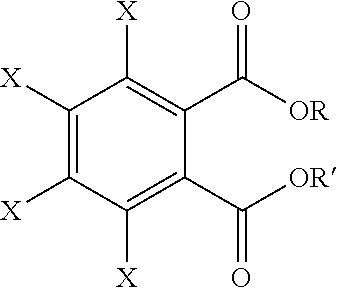Plasticized polyvinyl chloride composition with flame retardant
a technology of plasticized polyvinyl chloride and flame retardant, applied in the direction of coatings, etc., can solve the problems of increasing the flammability of conventional pvc, increasing the demands and increasing the demand for flame retardant properties. , to achieve the effect of low temperature flexibility
- Summary
- Abstract
- Description
- Claims
- Application Information
AI Technical Summary
Benefits of technology
Problems solved by technology
Method used
Image
Examples
examples
[0046]For Examples 1-3, the base PVC polymer, plasticizer, stabilizer, flame retardant synergist, and the dialkyl tetrahalophthalate-brominated / chlorinated paraffin mixture were combined and thoroughly mixed. Initial mixing of the ingredients was carried out in a blender. The resulting charge was transferred to a 2 roll mill and preheated to 350° F. for fusion and further mixing. Rolling time was for 5 minutes under 1260 psi compression at 337° F. for compression molding of the mixture into test sheets.
[0047]The standard for PVC compression molding as known in the art is described in standardized test methods ASTM Designation: D-1928-90 and ASTM D-746, which are herein incorporated reference. Standardized test methods ASTM D-1928-90 and ASTM D-746 disclose the protocol for preparing compression molded polyethylene test sheets and PVC compression molding of the mixture into test specimens. In the present case, the specimens prepared according to these standards were subjected to phys...
examples 1-3
[0054]Examples 1-3 were prepared and tested according to the procedures discussed above. The proportions, components and test results are presented in Table 1.
TABLE 1Example 1(CONTROL)Example 2Example 3PVC Resin (Geon 30)100100100Trioctyl Trimellitate34.334.334.3(UNIPLEX 546-A)Bis (2-Ethylhexyl—20—tetrachlorophthalateBrominated / Chlorinated—1010Paraffin(DOVERGUARD 9119)Bis(2-Ethylhexyl30—20tetrabromophthalate)(UNIPLEX FRP-45)Antimony Oxide555Calcium-Zinc Stabilizer555Tensile Modulus at 100%176020701900Shore A Hardness (ASTM888890D-224095, A Scale)Tensile Strength at Break205034803330(ASTM D638-95)Elongation (%)(ASTM278390360D638-95)Oxygen Index (ASTM333741D2863-95)NBS Smoke(ASTM E662-44024026595)Brittleness Temperature,−12−40−32° C. (ASTM D746-95)
[0055]The data in Table 1 shows that Examples 2 and 3 exhibited improved tensile modulus, tensile strength, elongation, oxygen index, smoke and brittleness relative to the control of Example 1. Both Examples 2 and 3, respectively, exhibited ...
PUM
| Property | Measurement | Unit |
|---|---|---|
| temperatures | aaaaa | aaaaa |
| temperatures | aaaaa | aaaaa |
| viscosity | aaaaa | aaaaa |
Abstract
Description
Claims
Application Information
 Login to View More
Login to View More - R&D
- Intellectual Property
- Life Sciences
- Materials
- Tech Scout
- Unparalleled Data Quality
- Higher Quality Content
- 60% Fewer Hallucinations
Browse by: Latest US Patents, China's latest patents, Technical Efficacy Thesaurus, Application Domain, Technology Topic, Popular Technical Reports.
© 2025 PatSnap. All rights reserved.Legal|Privacy policy|Modern Slavery Act Transparency Statement|Sitemap|About US| Contact US: help@patsnap.com

